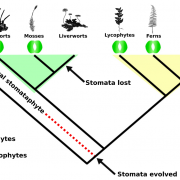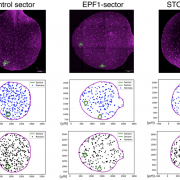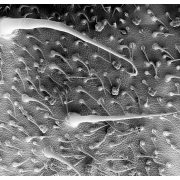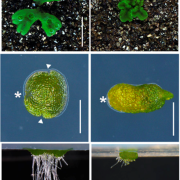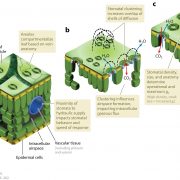Deceleration of cell cycle underpins a switch from proliferative-to-terminal division in plant stomatal lineage (bioRxiv)
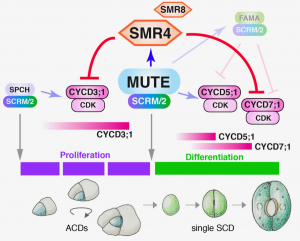 Precise cell cycle control is essential for the differentiation of specialized cell types. Stomata, essential pores for gas exchange located in the epidermis, are generated via proliferative asymmetric cell division (ACD) of a transient stem cell called a meristemoid, which will give rise to a guard mother cell that will undergo a single symmetric cell division (SCD) to generate a pair of guard cells that will terminally differentiate into a mature stoma. However, although the general developmental pathway for stomata development is well understood, how the precise mechanism that controls the switch from proliferative ACDs-to-SCD is currently obscure. A recent paper by Han and colleagues sheds light on the matter by identifying the cyclin-dependent kinase inhibitor (CKI) SIAMESE-RELATED4 (SMR4) as a key player for the ACD-to-SCD transition during stomata development. After having observed through time-lapse imaging that cell cycle duration during ACD is shorter than during SCD, the authors turned their attention to CKIs, well-known negative regulators of cell cycle progression. Transcriptome and ChIP-seq analyses identified the SMR4 CKI as a direct target of MUTE, master transcription factor key for the ACD-to-SCD switch. Subsequent analyses using fluorescent reporter lines revealed that SMR4 is expressed during late meristemoid development through SCD, while loss-of-function (LOF) smr4 mutants showed an increase in the number of stomata and stomata-precursor cells, indicating that SMR4 acts as a repressor of ACD. Furthermore, the authors measured cell cycle duration in plants ectopically expressing SMR4 and discovered that indeed SMR4 significantly slowed down the cell cycle through G1 extension. Finally, the authors showed that SMR4 exerts its function by physically interacting with the essential ACD and SCD regulators CYCD3;1 and CYCD7;1, respectively, as evidenced by the fact that ectopic expression of CYCD3;1 and CYCD7;1 mimics the LOF smr4 phenotype (increased number of stomata and stomata-precursor cells). This elegant work adds to the nascent notion that particular combinations of cell cycle regulators deployed at highly specific developmental stages carry out crucial roles in maintaining the proliferation/differentiation balance. (Summary by Jesus Leon @jesussaur) bioRxiv 10.1101/2021.05.17.442671
Precise cell cycle control is essential for the differentiation of specialized cell types. Stomata, essential pores for gas exchange located in the epidermis, are generated via proliferative asymmetric cell division (ACD) of a transient stem cell called a meristemoid, which will give rise to a guard mother cell that will undergo a single symmetric cell division (SCD) to generate a pair of guard cells that will terminally differentiate into a mature stoma. However, although the general developmental pathway for stomata development is well understood, how the precise mechanism that controls the switch from proliferative ACDs-to-SCD is currently obscure. A recent paper by Han and colleagues sheds light on the matter by identifying the cyclin-dependent kinase inhibitor (CKI) SIAMESE-RELATED4 (SMR4) as a key player for the ACD-to-SCD transition during stomata development. After having observed through time-lapse imaging that cell cycle duration during ACD is shorter than during SCD, the authors turned their attention to CKIs, well-known negative regulators of cell cycle progression. Transcriptome and ChIP-seq analyses identified the SMR4 CKI as a direct target of MUTE, master transcription factor key for the ACD-to-SCD switch. Subsequent analyses using fluorescent reporter lines revealed that SMR4 is expressed during late meristemoid development through SCD, while loss-of-function (LOF) smr4 mutants showed an increase in the number of stomata and stomata-precursor cells, indicating that SMR4 acts as a repressor of ACD. Furthermore, the authors measured cell cycle duration in plants ectopically expressing SMR4 and discovered that indeed SMR4 significantly slowed down the cell cycle through G1 extension. Finally, the authors showed that SMR4 exerts its function by physically interacting with the essential ACD and SCD regulators CYCD3;1 and CYCD7;1, respectively, as evidenced by the fact that ectopic expression of CYCD3;1 and CYCD7;1 mimics the LOF smr4 phenotype (increased number of stomata and stomata-precursor cells). This elegant work adds to the nascent notion that particular combinations of cell cycle regulators deployed at highly specific developmental stages carry out crucial roles in maintaining the proliferation/differentiation balance. (Summary by Jesus Leon @jesussaur) bioRxiv 10.1101/2021.05.17.442671


